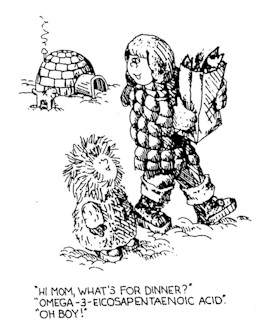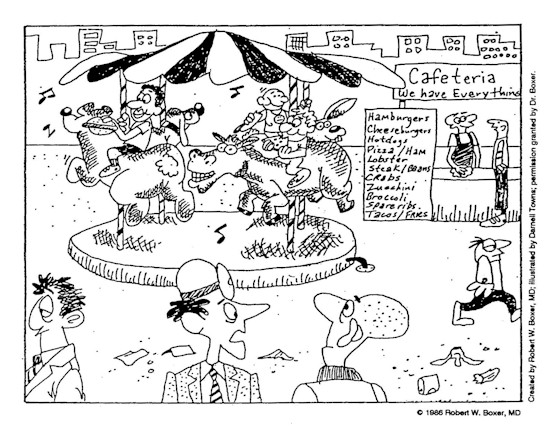THE FISH AND GAME DIET
An editorial by Marjorie Fisher
I have enjoyed the "rotation diet" since early in 1979. My personal name for it is the "Fish and Game Diet."
Beatrice Trum Hunter, NOHA’s good friend and honorary member, sent me an article1 which reinforced my confidence and joy in distancing myself from a "Bread and Butter" diet. The authors, S. Boyd Eaton , MD, and Melvin Konner, PhD, state, "Adults living before the development of agriculture and animal husbandry derived all their nutrients from the first two food groups (meats and fish, vegetables and fruit); they apparently consumed cereal grains rarely, if at all, and they had no dairy foods whatsoever. Nevertheless, with a diet containing 35 percent meat, their calcium intake would have far exceeded the highest estimate of minimum daily requirement" recommended today. Also, "the probable Paleolithic intake of dietary fiber was much higher than ours and approached that common in rural Africa, where disease conditions linked with deficient dietary fiber rarely occur, although Paleolithic human beings obtained their fiber predominantly from fruits and vegetables rather than grain." The shift from big-game hunting to agriculture "had prominent morphologic consequences: early European Homo sapiens, who enjoyed an abundance of animal protein 30,000 years ago, were an average of six inches taller than their descendants who lived after the development of farming. The same pattern was repeated later in the New World: the Paleoindians were big-game hunters 10,000 years ago, but their descendants in the period just before European contact practiced intensive food production, ate little meat, were considerably shorter, and had skeletal manifestations of suboptimal nutrition. . . . Since the Industrial Revolution, the animal-protein content of Western diets has become more nearly adequate, as indicated by increased height: we are now nearly as tall as were the first biologically modern human beings. However, our diets still differ markedly from theirs, and these differences lie at the heart of what has been termed ‘affluent malnutrition’."
The shift from big-game hunting to agriculture "had prominent morphologic consequences: early European Homo sapiens, who enjoyed an abundance of animal protein 30,000 years ago, were an average of six inches taller than their descendants who lived after the development of farming."
The "Fish and Game Diet" is appealing. The game meats contain much less fat than the beef produced by agribusiness, and the small amount of fat in game meats is different, much more unsaturated and even contains a little eicosapenentanoic acid, a beneficial "omega-3" fatty acid found in fish.2 "In comparison with us, our Paleolithic ancestors consumed more structural fat and less depot fat."3 Structural fat is used in all our cell walls and is needed especially for the brain.4

Courtesy of Jeffrey
Bland, PhD
author of Nutraerobics
Imagine yourself experimenting with new fruits and vegetables along with fish and game. My slogan is "Enjoy Nutritious Variety"! The rotation diet involves eating any one food only once in four days, and food from the same biological family only every other day. The variety is quite astounding to the uninitiated. For "game" I choose many kinds of "exotic" meats: hippo, llama, kangaroo burgers as well as venison, buffalo, and sometimes rabbit stew; beaver legs and wonderful Muscovy ducks. In regard to fish, I was much impressed by an article, "Use of Fish in the Rotary Diversified Diet," by Lawrence D. Dickey, MD, in Very Basically Yours, An Allergy Cookbook, in which he emphasizes the tremendous variety of eatable fish. "There are almost twice as many different families of sea and fresh water fish that may be used as food as amphibian and land animals combined."
To me bread is no longer "the staff of life." Looking back to when I first questioned our cultural axiom that grains are essential, I remember reading Sweet and Dangerous by the English doctor, John Yudkin, about a dozen years ago. He wrote mainly about the dangers of over-consumption of sugar. However, what most impressed me was his mention that the cultivation of grains and in fact all agriculture is only a recent episode in the history of mankind. We are really adapted to eating wild game and fruits and vegetables that are gathered wild. Manufactures have cashed in on our love of fruit by using cheap sweeteners in their processed foods and they take advantage of our love of meat flavor by imitating it in processed vegetable products.
My real awakening to the possibilities for change and variety in one’s diet came when our son was tested for food sensitivities in Dr. Theron G. Randolph’s environmental control unit at the American International Hospital in Zion, Illinois, in 1977. It was a revelation to see the test meals of a very large amount of simply one food cooked in compatible water. There was never any question of not having enough at a meal. He could eat to satiety. I began to read the literature. Then in December, 1978, Dr. Randolph spoke for NOHA on "Food Addiction." I had never thought of using the rotation diet myself until Dr. Randolph’s lecture convinced me to try it. I had incipient arthritis in my hands. I had always felt that my hands were strong. However, at that time I had been suffering for a number of years from pain at the base of each thumb so I was literally loosing my grip. Both my parents developed badly crippled hands. In the middle 1970s I tried supplementing with large amounts of Vitamin B6 in addition to the other vitamins that I then took regularly. I was following the information given by a NOHA speaker, Dr. Ellis, who wrote Vitamin B6, The Doctor’s Report. In about a month I noticed improvement. However, in a little less than a year the old pains returned in spite of the supplementation and a supposedly "excellent" diet that included lots of wheat germ, etc.
Manufactures have cashed in on our love of fruit by using cheap sweeteners in their processed foods and they take advantage of our love of meat flavor by imitating it in processed vegetable products.
So much for my situation before January, 1979. From my reading in the field of clinical ecology I recalled that the symptom-producing foods for a particular person were often those they craved and/or those they disliked. In my case, I recalled that as a child I had not liked bread or even cake, so I decided to eliminate all grains from my diet. When my children were growing up I had made lots of wheat germ cookies and whole wheat bread for them. In February 1979 after returning from a vacation, I began eliminating all grain and supplements from my diet and started a "rotation diet." Gradually the pain in my thumbs subsided. I had a few enlightening experiences when the pain returned after I’d eaten a slice of bread and once I even got sharp pains in a foot as well as my thumbs—something that had not happened before! I continued to be very careful about grains. After avoiding them completely for over a year, I can now eat them at one, or occasionally two meals a week spaced at least two days apart with no symptoms at all!

"No this is not what Dr. Rinkel meant by a rotary diversified diet"
While using the "rotation diet" I became very interested in new foods, and introduced lots of variety into my diet. As I mentioned, I’ve enjoyed all sorts of wild game as well as many varieties of fish in my "Fish and Game Diet." I’ve also had fun trying new kinds of vegetables and fruits. In the introduction to a recipe book I found this statement by Dr. Randolph, "For most affected persons, recipes are not for day-in and day-out use." (emphasis in the original). In other words, recipes which combine many different foods are only to be used occasionally "for birthdays and other special occasions." I was stimulated to write a little booklet, Enjoy Nutritious Variety: Rotation Diet, which I gave to NOHA. For easy reference it has the foods in their families also indexed alphabetically and it has actual examples of four day rotations eliminating different foods. I enjoyed taking these examples from my food diary. They include many simple meals often not requiring cooking — especially the lunches which could easily be taken to work. For vegetables at dinner, I would often choose a root vegetable and deep green vegetables from the same food family (e.g., carrots, celery, and parsley) and have them both raw and cooked in spring water. This gives us variety in texture and nutrients all from the same family.
In NOHA’s booklet I extol variety: Feel venturesome, try game meats and fish you’ve never tried before; experiment with fruits and vegetables that are new to you!
_________________________________
1 "Paleolithic Nutrition, A Consideration of its Nature and Current Implications," The New England Journal of Medicine, Vol. 312, No. 5, pp 283-89, January 31, 1985. This article was reviewed in NOHA NEWS, Spring, 1985, "Return to the Stone Age?"
2 Ibid., pp 285.
3 Ibid., pp 288.
4 In the next issue of NOHA NEWS we plan to include more information about structural fats when we review the book, What We Eat Today by Michael and Sheilagh Crawford.
Article from NOHA NEWS, Vol. XI, No. 4, Fall 1986, pages 1,3-4.
ENJOY NUTRITIOUS VARIETY
ROTATION DIET
by
Marjorie Fisher
may be purchased for $3.00,
including postage,
handling, and Illinois tax from
NOHA
P.O. Box 380, Winnetka, Illinois 60093